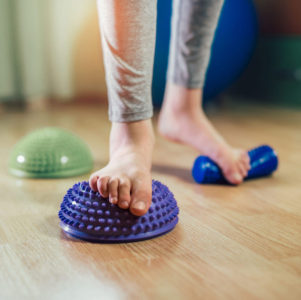 Proprioception is a term that describes our body’s ability to recognize where parts of it are in space. It may sound a little confusing, but it’s something your body does naturally as you move. For example, if you got in your car and closed your eyes, you would still be able to reach up and find the steering wheel with your hands with relative ease, because even without looking, you have a natural understanding of where your hands are in space and roughly where they need to go in order to grab the wheel.
Proprioception is a term that describes our body’s ability to recognize where parts of it are in space. It may sound a little confusing, but it’s something your body does naturally as you move. For example, if you got in your car and closed your eyes, you would still be able to reach up and find the steering wheel with your hands with relative ease, because even without looking, you have a natural understanding of where your hands are in space and roughly where they need to go in order to grab the wheel.
Proprioception can apply to any area of your body, but for this article, we’re going to focus on proprioception of your feet and ankles, because these areas play a crucial role in your balance. Considering how dangerous falls can be to older adults, improving your proprioception can greatly reduce your risk of suffering an injury from falling.
But it’s not just seniors that could benefit from improved proprioception. Basketball players, soccer players and football players all rely on quick and precise movements, and being able to naturally recognize your body in space can make all the difference in finishing that layup after getting fouled or kicking that ball precisely so it goes exactly where you want it to go. So whether you’re young or old, we encourage you to check out these tips for improving proprioception in your feet and ankles.
Improving Foot Proprioception
The easiest way to improve your brain’s ability to recognize your feet and ankles in space is by conditioning it with exercises. There are hundreds of different exercises you can perform to achieve this, and while we’ll touch on a few of those a little later, there are a few more important keys than which specific exercise you perform. If you really want to improve your foot proprioception, you need to perform these exercises daily (multiple times a day is even better), and you need to eventually progress to more difficult exercises in order to continue to improve your proprioception instead of letting it plateau. So instead of focusing on a specific set of exercises, really make sure you’re doing your exercises at least once a day, and eventually take on more challenging exercises.
With that in mind, here’s a look at a couple of proprioception-focused exercises to perform, and how you can take the exercise to the next level to challenge yourself.
One Legged Stands – Stand on one leg and try to maintain your balance for 15 seconds.
Blind One Leg Stands – Perform the same exercise, but close your eyes while you do it.
One Legged Stand Grabs – Stand on one foot, toss a coin on the ground in front of you, and then bend over and try to pick it up while balancing on one leg.
Blind One Leg Stands With Head Motion – Balance on one leg with your eyes closed, then slowly move your head side to side and front to back, all while remaining balanced.
Blind One Leg Stand And Grabs – Finally, balance on one leg, place a couple coins on the ground, close your eyes and bend over and retrieve the coins, all while maintaining your balance. This will test your ankle, foot and hand proprioception at the same time!
And if you’re struggling with your balance and want some 1-on-1 help, reach out to Dr. Silverman’s office today to set up a consultation!